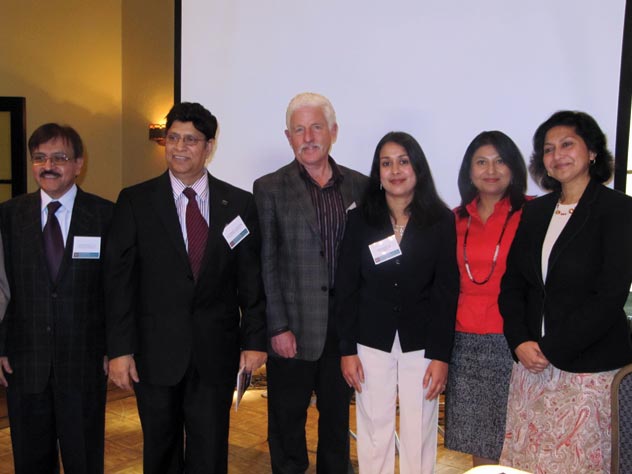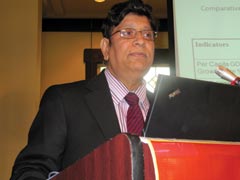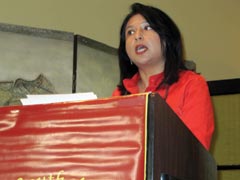SYMPOSIUM
Bangladesh Hopes and Challenges: Berkeley Conference
In a symposium headlined by a stirring speech by Bangladesh’s UN envoy, Berkeley academics highlighted challenges and achievements of contemporary Bangladesh Nov. 12. A Siliconeer report.

(Above): Participants pose Nov. 12 for a photograph after a symposium on Bangladesh at the University of California at Berkeley (l-r): Ahmed Badruzzaman, Bangladesh’s Permanent Representative to the U.N. A.K. Abdul Momen, Allan Smith, Sanchita Saxena, Ananya Roy and Isha Ray.
To the chagrin of many a Bangladeshi, and not a few sympathizers of that densely populated nation all over the world—the nation has become a byword for poverty, backwardness and misery in any discussion of international policymaking.
To be sure, Bangladesh faces daunting problems, not the least of which is a huge population squeezed in a small landmass that faces a dire threat of global warming which could put even a lot of that precious space underwater. Corruption and political unrest are also facts of life.
However, that’s not the whole story—far from it.
This cash-strapped nation has made considerable strides in female literacy, infant mortality and population control, and is ahead of India in many of these indicators despite a much lower per capita income.
Led by a Bangladeshi diplomat, four experts from the University of California at Berkeley talked about policy areas critical to Bangladesh’s growth and development. The keynote address by delivered by Dr. A. K. Abdul Momen, Bangladesh Permanent Representative, United Nations.
 (Left): Bangladesh’s Permanent Representative to the U.N. A.K. Abdul Momen (Left): Bangladesh’s Permanent Representative to the U.N. A.K. Abdul Momen
Momen is refreshingly different from a conventional diplomat, and for good reason. A professional diplomat he is not. He is a U.S. college professor with a long-standing record of human rights activism and community engagement which has got him in trouble with intolerant Bangladeshi governments before.
He made a compelling case—complete with data and statistics (he is, after all, a college professor by profession)—that democracies invariably perform better than autocratic states in improving economic growth and prosperity. He also talked about Bangladesh’s impressive record in terms of socio economic indicators and Prime Minister Sheikh Hasina’s dream of 100 percent literacy.
Another issue that was on his mind was the threat that Bangladesh faces due to climate change. He called on Bangladeshis in the U.S. to mobilize support in the U.S Congress for a robust U.S. commitment to battling global warming.
Ahmed Badruzzaman, a scientist with Chevron who also teaches at Berkeley, spoke about the twin challenges that Bangladesh faces in terms of its growing energy needs and climate change.
Rising CO2 emissions pose a potent threat for countries like Bangladesh. Increased floods, melting of glaciers and the polar ice cap will lead to a horrendous global scenario of submergence of the Ganges-Brahmaputra, Nile, Mekong and Mississippi basins.
The only way to deal with the challenge is mitigation and adaptation, and he suggested the use of alternative energy and transfer of technology from developed countries, which have the wherewithal and skills to cope better.
Bangladesh will need to plan for adaptation. Issues that deserve close consideration include introduction of flood resistant rice, building infrastructure to deal with climate refugees due to the rise of sea level.
Bangladesh also needs to think regionally, he said, because “climate doesn’t know any regional boundaries.”
 (Right): Ananya Roy (Right): Ananya Roy
Ananya Roy, a professor of city & regional planning, talked about the remarkable role of non governmental institutions in presenting a “possibility of an alternative model of development.”
Roy is an author of a book on which studies those who manage poverty and sheds light on how powerful institutions control «capital,» or circuits of profit and investment, as well as «truth,» or authoritative knowledge about poverty. Such dominant practices are challenged by alternative paradigms of development, and the book details these as well. Using the case of microfinance, the book participates in a set of fierce debates about development - from the role of markets to the secrets of successful pro-poor institutions.
While the work of Grameen Bank founder Mohammad Yunus is more widely known, Roy also talked about the substantive efforts of Bangladesh Rural Advancement Committee or BRAC, founded during Bangladesh’s independence movement in 1971 by a visionary development thinker, Fazle Hasan Abed.
BRAC and Grameen do a lot more than microfinance, she said. In particular, BRAC’s work is deeply informed by the experience of the independence movement, when Abed gave up a corporate career to work in relief work. After independence, that transmuted into development work, and today the two are coupled.
Allan Smith, professor of epidemiology in the School of Public Health, spoke about the continuing crisis of arsenic poisoning in Bangladesh.
He called the arsenic crisis the “largest poisoning of a population in history.”
From December 1996 to January 1997, a three-week survey was conducted by the Dhaka Community Hospital and the School of Environmental Studies. The survey team visited 18 affected districts. Of the 1630 adults and children examined, 57.5 percent of them had skin lesions due to arsenic poisoning. In another study, approximately one-third of the 7364 patients examined had skin lesions due to arsenic.
The population of the 42 affected districts was 76.9 million. These studies do not imply that the entire population is drinking contaminated water. A recent report from the World Bank has estimated that 20 million inhabitants of Bangladesh may be drinking arsenic-contaminated water.
The health effects of ingesting arsenic-contaminated drinking-water appear slowly. For this reason, a more important issue than the number of patients who currently have arsenic-caused diseases in the number who will develop these diseases in the future as a result of past and continuing exposure to arsenic. Large numbers of tubewells were installed in Bangladesh approximately 5 to 20 years ago. If the population continues to drink arsenic-contaminated water, then a major increase in the number of cases of diseases caused by arsenic may be predicted.
Sanchita Saxena, associate director of Berkeley’s Center for South Asia Studies, talked about the remarkable success of Bangladesh’s garment industry.
The last several decades have seen Bangladesh’s dependence on the garment sector grow significantly. In 1983, there were about 50 garment factories in the country. By 2004, this number had jumped to 4,000. Exports have increased from a meager $68 thousand in 1968 to $5.7 billion in 2004. Currently, this sector employs approximately 2.2 million workers, of whom almost 80 percent are women. This sector has created enormous economic opportunities for the country’s women, who until the late 1970’s were almost non-existent in the labor force.
Bangladesh owes much of its success in the global garments and textiles market to the system of quotas that were in place for several decades under the Multi-Fiber Arrangement. After guaranteeing market share to countries for more than thirty years, the MFA was phased out in 2005. All the pundits predicted that once the quotas were lifted and all WTO members would have unfettered access to the developed countries’ markets, many of the “smaller” and less competitive Asian countries, like Bangladesh, would drastically lose market share especially to China. To the contrary, however, the data over the last three years shows that many of these “smaller” countries including Bangladesh, Cambodia, and Pakistan have in fact increased their garments exports to the U.S. and E.U.
There is growing convergence among groups like factory workers, owners and the government in terms of what needs to be done, Saxena said. The raise in minimum wage law enacted in 2006 has been implemented in 2008. Benefits to workers in term of wages, health care and child care are improving, and most importantly, workers say everybody is paying more attention to their needs.
|